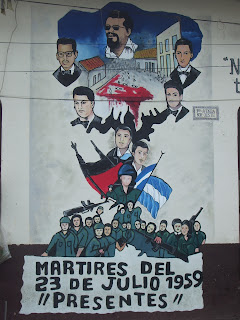FROM THE COAST TO THE JUNGLE

We were rudely welcomed to Nicaragua with the most pot-holed road we’ve ever experienced. Infrastructure in Nica is by far the worst in Central America, making it plainly obvious that this is the poorest country in the region. A long and violent history of dictatorships and socialist uprisings have slowed progress here, but it seems that things are on the up and up now. The city of Leon is scattered with political murals (see photo) of the past fighting. The people all seem very proud of this history and keen to tell their stories. An old man stopped us in the street of Leon to tell us his stories of murdered students and show us a photo of him firing a bazooka. Makes our Australian history seem pretty tame in comparison.
Shakin’ it in Nicaragua
The town of San Juan del Sur was our home for a week while we completed yet another week of Spanish language classes, including another home stay with a local family. For a week we ate like kings (mama was an awesome cook) and lived the life of the locals in San Juan. The photo shown is from the Central American Independence Day festival on 15 September, which we were lucky enough to be in San Jaun to see. The festival included this sassy display by the local high school, parading around town shaking their hips. This seemed to be quite a progressive show for such a strongly Christian community. 
Also in San Juan, we found a local program providing potable water filters to schools and the community, where we could volunteer our skills. The municipal water supply is generally not suitable for drinking without treatment, which is the same for most of Central America. For people that can’t afford to buy drinking water, the simple sand filters removed biological and mineral contaminants making the water safe to drink. We learnt first hand that they are constructed using concrete casts and filled with a sandy aggregate which acts as the filter (simple technology, but effective). We were able to help with the construction of the filters, but we only managed to make two of the 200 filters required by the program while we were there. It’s a slow process.
Plate of the Day
Our Spanish schooling was completed with a visit to a local pottery workshop, where we saw ceramic pieces made from scratch on a manual pottery wheel. After this we headed out to a traditional festival, where we gorged ourselves on the ‘plato del tipico’ (photo) and knocked back a few Flor de Cañas (the local rum) and coke while watching traditional dancing. 
Crossing the border to Costa Rica, the roads improved (which was good because our van was sounding rough after Nicaragua). As luck would have it, we met up with Joe and Amy again by chance. It was great to see some familiar faces. We stopped in the surf town of Jaco for some waves and repairs on our van, and continued south to Manuel Antonio National Park. The birds and other wild life seem a lot more plentiful here, however we are still yet to see a sloth. Possibly in the national parks on the Osa Peninsula, which is where we were headed next. 
No sloths identified unfortunately, but plenty of monkeys. We spent three rain drenched days in the national park of the Osa Peninsula, Southern Costa Rica. The area is known as the wettest part of the region and October, as it turns out, is the wettest month in this part of the world (which we can whole heartedly attest to). Rain aside, the peninsula was spectacular and full of wildlife. We saw heaps of howler monkeys, white faced monkeys, scarlet macaws and a coatis (a cat-like/bear creature). From here we are heading for Panama, sadly the last stop of our road trip.



No comments:
Post a Comment